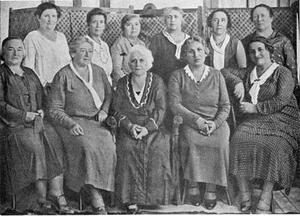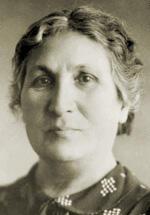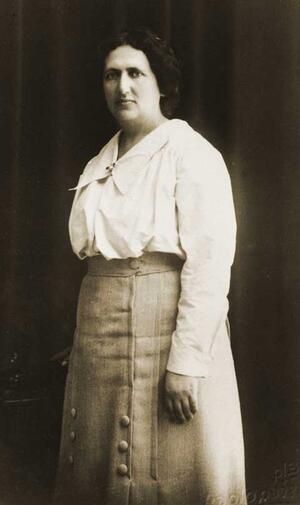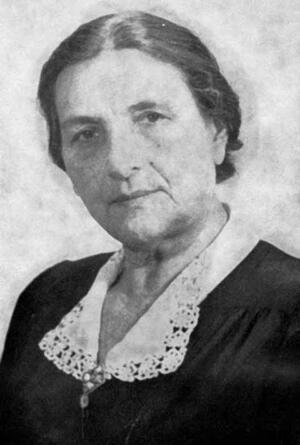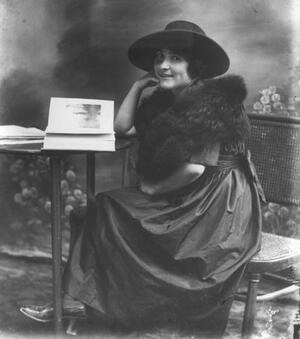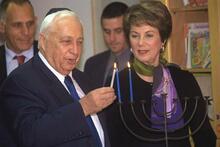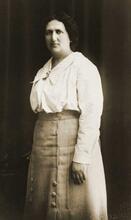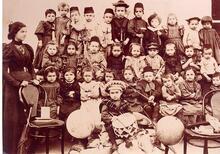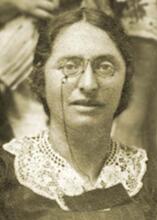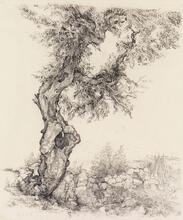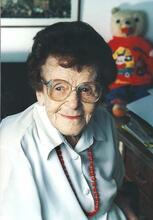Second Aliyah: Women's Experience and Their Role in the Yishuv
Courtesy of Ha-Keren le-Ezrat ha-Isha.
Women of the Second Aliyah, in the civil as well as the labor sector, played an important part in shaping new Hebrew society and paving the way for the establishment of the state of Israel. The most noticeable change in female immigrants of the Second Aliyah was their level of education, and their desire for self-actualization and economic independence through work outside the home. They viewed their work as essential to the Zionist project. As such, the participation of women in the building of the physical land was also a feature of the new Hebrew civil woman. While prevailing historiography of the Second Aliyah views the adoption of masculine work and qualities as an authentic feature of the new Hebrew women, a new analysis shows that in the civil sector women saw every Yishuv occupation as work of national importance, including those that were unmistakably feminine.
Around 30,000 Jews immigrated to Ottoman Palestine during the period of the Second Aliyah (1904-1914). Half joined the Orthodox community, known as the “Old Yishuv,” while half joined the Zionists, or the “New Yishuv.” During this decade one can discern in the New Jewish community in Palestine prior to the establishment of the State of Israel. "Old Yishuv" refers to the Jewish community prior to 1882; "New Yishuv" to that following 1882.Yishuv the beginnings of the Israeli milieu and most of its components: an active leadership in the fields of settlement, education, policy making, defense, and law; high schools; and cultural organizations and institutions—Bezalel (the first national art school and workshops), the Hebrew Theater Lovers’ Circle, the Institute for Songs of Israel, the Hebrew Musical Society and Maccabi, to name but a few. Women took part in most of these new endeavors.
The historiography of the Yishuv has generally held this period in high regard because of the assumption that the workers of the Second Aliyah – the “Pioneers” – shaped the new Hebrew society and included the most influential leaders who established the state of Israel. This entry, by contrast, focuses on the women of the Second Aliyah who worked in the “civil sector” (the accepted term for the non-labor segment of society) and argues that they were at least as important to the development of the Yishuv as the labor women, if not more so.
Women's Awareness of Economic Independence and the Importance of Female Labor in Building the Land
Although many scholars depict nationalism, Zionism, and masculinity as having been virtually synonymous in the Yishuv, Billie Melman argues in her important article on gender and “Israeliness” that “both femininity and masculinity were central components of the cultural model of the new individual in pre-State Palestine” (Melman 1997)
Already during the First Lit. "ascent." A "calling up" to the Torah during its reading in the synagogue.Aliyah, men had cited the importance of women’s Zionist awareness to the success of the national revival. The historian Joseph Klausner, who paid a lengthy visit to Palestine in 1911, noted the connection between women’s intellectual level, in particular their knowledge of Hebrew, and their families’ success in integrating into the country: “[B]ecause most of them have not learned Hebrew, and they are the ones unable to bear the ‘tribulations of the Land of Israel’ since they have not been infused with a love of the Land, it is they who typically cause many families to leave the country.” (Klausner 1912–1913). Like many others, Klausner emphasized the importance of women’s Hebrew cultural base but made no reference to the question of their occupations.
The most noticeable changes among women immigrants of the Second Aliyah were the high school, or even university, education some received in the Diaspora prior to their immigration, and their awareness of the need to devote themselves to working outside the home as a path to both self-actualization and economic independence. The need for economic independence is cited by Arthur Ruppin, director of the Palestine Office, as a goal his wife Shulamit (Selma) set for herself even prior to her immigration to Palestine. Coupled with the desire for economic independence was an oft-cited additional factor unique to Palestine: the realization of the importance of working outside the home to the entire endeavor of building the land.
It is no coincidence that a number of women who left autobiographies with detailed accounts of their activities and ideas candidly related their personal development as working women in the Land of Israel. Sara Azaryahu, a teacher who penned her life story when she was in her eighties, summed up her life in these words: “From the earliest days of my youth, I began to ponder two problems in particular: (a) the bitter fate of my wandering, persecuted people; (b) the downtrodden status of women in the family” (Azaryahu 1957, 12). Azaryahu asserted that she did not feel any discrimination in her own family, but her concern for the status of women in society led her “intuitively” to the conclusion that “the independence of women in the material sense could raise their status” (ibid). Like the male and female laborers of the Second Aliyah, Azaryahu saw her immigration to Palestine as a revolutionary act: “I am going to join a rather small group of eager and courageous revolutionaries” (ibid., 59). Her educational work, which centered on teaching girls in Jaffa, Jerusalem, and Haifa, and her later role as secretary of the Union of Hebrew Women for Equal Rights in Erez Israel, were directed towards solving the problems of the nation in general and women in particular. To her way of thinking, self-actualization, economic independence, social reform, and national reform were inextricably interwoven.
The revealing autobiography of kindergarten teacher Shulamit Flaum, Bat Yisrael Nodedet (Wandering Daughter of Israel), offers a rare glimpse into the world of a young woman blessed with profound self-awareness. In her words: “I also believed in awakening the ‘I’ of women” (Flaum 1936, 48). While still residing in Germany, she read a great deal about famous Jewish women of both the recent and distant past. Flaum, who saw her life as “a holy mission of humaneness” (ibid., 30), stressed that in her youth she felt she had a threefold goal: achieving economic independence, educating the younger generation, and participating in the building of the Land. Flaum, who studied pedagogy in Germany, saw the care of children as a mission but also as a means of “maintaining my independence with my own two hands—something I have always striven for” (ibid., 26). According to Flaum, her aliyah to Palestine originated in a “recognition of my responsibility to the history of my people and my desire to tie my destiny to that of the Jewish people” (ibid., 30). She admitted that she was eager to make the journey to Palestine, both because of her desire to get to know new worlds and her desire to “participate in the building of the new land of Israel and in educating the generation of the revival” (ibid., 34).
Judith Eisenberg Harari (1885–1979), who arrived in Palestine at the age of one year, dreamt of activity, of deeds, of independence, of participating in the building of the Homeland. For Harari, these three values—educational activity, economic independence and building the homeland—were interconnected.
The desire of non-labor women for economic independence and the awakening of their feminist awareness were uniquely connected with their wish to play a significant role in the building of the land—and this theme recurs repeatedly in their writing. Aliyah to Palestine is frequently perceived as a transformation, a rebirth, the ultimate opportunity for self-actualization. In her letter to poet Hayyim Nahman Bialik on the eve of her aliyah, the artist Ira Jan expressed this hope: “… because I wish to live the life of a free artist. There, in the Land of Israel, which has begun to attract me more and more each day …” (Kolodny 2003). And after her aliyah, she declared: “Something new is coming into being here. It is so uplifting when you see new things blossoming here.” In the non-labor sector of the Jewish community in Palestine prior to the establishment of the State of Israel. "Old Yishuv" refers to the Jewish community prior to 1882; "New Yishuv" to that following 1882.Yishuv, a new Hebrew woman was being shaped: not a male Eve, a woman who dressed and acted like a man, as in the identity of some of the prominent labor women, but as a new female Eve.
Women's Involvement in Work Outside the Home
Two documents pertaining to women’s occupations in Palestine during this decade are particularly instructive: a letter from Menahem Sheinkin (1871–1924), director of Members of Hibbat ZionHovevei Zion’s information and immigration office in Jaffa, and an article by the activist Sarah Thon published in the Zionist newspaper Die Welt in 1910. In response to a question about work opportunities for women in Palestine, Sheinkin explained that the occupations available for women in Palestine were as kindergarten teachers, seamstresses, medical assistants, midwives, masseuses, dentists, and cooks. In his words: “Not only in Palestine but everywhere, it is harder for a woman to get by than for a man. Women receive inferior preparation for life’s struggles” (Sheinkin, 1907).
A somewhat more encouraging view was presented three years later by Thon. In an article entitled “Women’s Work in Palestine,” Thon declared that women’s work in Palestine was “extraordinarily important,” and that the goals of building the land were focused not only on making the desert bloom but also on achieving social reform—a reform that could not take place without the involvement of women. She offered the following detailed breakdown of the occupations of Jewish women in Jaffa, Jerusalem, Tiberias and Haifa:
| Occupations | Jaffa | Jerusalem | Tiberias | Haifa |
|---|---|---|---|---|
| Seamstress | 180 | 1 + many | 1 | few |
| Sock maker | 20 | |||
| Milliner | 1 | 2–3 | ||
| Shop girl | 2 | 1 | ||
| Cigarette maker | 2 | few |
But as vital as Sarah Thon considered women’s work in Palestine, the existing reality was a bitter disappointment. The above table confirms that only a small portion of urban Jewish women had the proper education to work in professional occupations and thus to help shape the public sphere, and most women who worked were employed in manual labor or in classically female professions: sewing, handicrafts, taking care of sick people, and teaching. Thon notes that “at present [1910], there is not even one woman employed in agricultural work in Judea. In Samaria, there are two … And in the Galilee, there are a few women laborers, whose total number does not exceed eight” (Thon 1912).
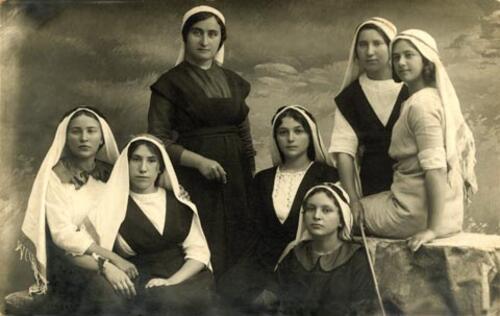
Under the leadership of Fania Metman-Cohen, the Herzlia Hebrew Gymnasia was the first educational institution in Palestine to promote gender equality in education, during the Second Aliyah period. Pictured here are students of the Gymnasia on a hike through Ein Gedi, April, 1912.
Courtesy of Tamar Eshel
A small number of outstanding urban women of the Second Lit. "ascent." A "calling up" to the Torah during its reading in the synagogue.Aliyah did fall under the definition of “civil,” or non-labor-affiliated. Fania Metman-Cohen, a kindergarten teacher, schoolteacher, and principal of a Zionist school prior to her aliyah, arrived in pre-State Palestine in the autumn of 1904 with her husband Yehuda Leib and their son. In 1905, together with her husband, she founded the Herzlia Hebrew Gymnasia in Jaffa—a goal that had, in fact, inspired their aliyah. This educational institution was a “first” in several areas: the first Hebrew secondary school in Palestine, the first educational institution that identified itself as religiously neutral, and the first co-educational post-elementary institution. Fania Metman-Cohen’s involvement in the founding of the school doubtless had an influence on the institution’s approach to gender. While the standard of equality was not always realized (it was Fania who washed the school’s floors, while Judith Harari was temporarily suspended from teaching due to giving birth to her only child, and Cila Feinberg, a student, was forced to fight for the right to wear trousers in gym class), the Herzlia Hebrew Gymnasia did succeed in introducing the notion of equal high school education for males and females into the Hebrew educational system of pre-State Palestine.
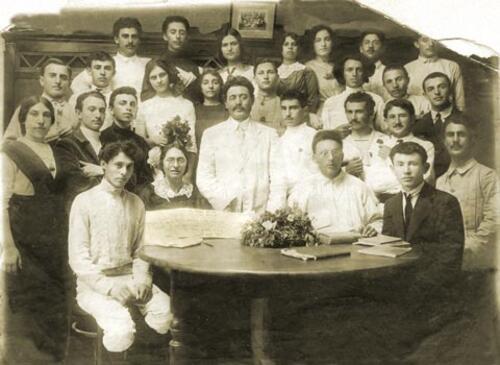
Yehuda Leib and Fania Metman-Cohen arrived in Palestine in 1904, during the Second Aliyah period. Two years later they established the Herzlia Hebrew Gymnasia in Jaffa, the first Hebrew secondary school in Palestine. Pictured here in 1913 is the first graduating class. Among those shown are (1)Yehuda Leib Metman-Cohen, Principal; (2) his wife Fania Metman-Cohen; (3) Dov Hos; (4) Moshe Shertok (Sharett); (5) Eliyahu Golomb; (6) Rivka Shertok, sister of Moshe; (7) Zilla Feinberg, sister of Avshalom; (8) Moshe Menuhin, father of Hephzibah, Yehudi and Yalta.
Courtesy of Tamar Eshel
In December 1907 Sarah Thon, who was involved in Zionist circles even before her marriage to Ya’akov Thon, immigrated to pre-State Palestine, where she represented the Women’s Association for Cultural Work in Palestine. Founded at the Eighth Zionist Congress in The Hague in 1907, the association set itself a double objective: to provide young women both with a means of livelihood and with a Hebrew education. Sarah Thon, who studied the promotion of handicraft skills both in Germany and in monasteries in Palestine, was successful in bringing this venture to fruition, founding craft workshops for hundreds of young women throughout the country, in Jaffa, Jerusalem, Tiberias, Ekron, and Safed. Thon was considered the person who “founded this industry in our country for impoverished young maidens” (Hacohen 1922). She managed the project and was aware of the important message she was disseminating—economic independence and Hebrew culture as characteristics of the new Hebrew woman.
Shulamit (Selma) Ruppin (1878–1912), a singer and music teacher, made aliyah in 1908 with her husband Arthur Ruppin. In 1910 she founded the first music schools in Jaffa and Jerusalem. For a professional musician like herself, the fostering of music education went hand in hand with the revival of Jewish society in Palestine. The rapidly changing Israeli reality and the prevailing sentiment that “wonderful things are beginning to take place in this country” (Kolodny 2003) represented an incentive and a challenge to renewed activity. In addition to motivating Jewish musicians to immigrate to Palestine and teach at her institutions, Ruppin persuaded affluent Zionists from Russia to contribute to this project, which was so dear to her heart. Even after her sudden death in 1912, the institutions she built continued to flourish.
Hasya Sukenik Feinsod began her Zionist activity prior to immigrating to Palestine, fighting to obtain pedagogical training while still in Europe. She made aliyah in 1912, specifically in order to run a Hebrew kindergarten and train student kindergarten teachers in the institutions of the Hilfsverein organization (Ezra) in Jerusalem. Sukenik Feinsod, who married the archeologist Eliezer Sukenik in Palestine, saw in the profession of kindergarten teaching a national tool of major importance through which “I could mend the rifts among our people, unite Jewish communities of different origins and start to build the nation from the ground up, to begin to educate a new generation” (Sukenik Feinsod 1966). Sukenik, who played an active role in the “Language Wars” over the use of Hebrew (1913), headed the Hebrew Seminary for Kindergarten Teachers founded in Jerusalem before World War I. (Two such seminaries were founded prior to this one, by the Ezra organization in Jerusalem and by Hovevei Zion in Jaffa.)
The uniqueness of these four women (three of whom also led the struggle for women’s suffrage in the [jwa_encyclopedia_glossary:432]Yishuv, while the fourth died at its inception) lies in the fact that they dared to create new institutions and develop spheres of activity that were hitherto unknown in the Yishuv. Alongside them came other women with similar goals—some alone, others accompanied by their husbands.
Sarah Gliklich, a teacher of handicrafts, immigrated in 1908, also in order to teach at the girls’ school in Jaffa. In 1919, Gliklich independently published a pamphlet on the rights of women. Amitah Pinchover, German-born and religiously observant, immigrated in 1909 and was appointed principal of the girls’ school of the Ezra organization in Jerusalem. She was among the first to join the Union of Hebrew Women. Ada Geller arrived in Palestine in 1911 and for ten years ran the crafts workshop founded in Jerusalem by the Women’s Organization for Cultural Work in Palestine. She later became the first female accountant in Palestine (1931) and a member of the Union of Hebrew Women.
Kindergarten teaching, a classic women’s occupation, drew several young women to Palestine: In addition to Shulamit Flaum, Rivkah bat Levi Taub, a graduate of the Pestalozzi Froebel Haus Teachers’ Seminary in Berlin, immigrated to Palestine in 1908 and later became a major activist in the Jerusalem branch of the Union of Hebrew Women. Yehudit Katinka came to Palestine in 1913. She too worked as a kindergarten teacher and was active in the Haifa branch of the Union of Hebrew Women for Equal Rights in Erez Israel, along with Dina Mayer Blum, who immigrated from Germany in 1914 and ran the seminary for kindergarten teachers of the Hilfsverein organization (Ezra). Harari (1959) refers to nine additional kindergarten teachers in Haifa.
Ira Jan (Esther Slopian) was born in Kishinev and graduated from the Moscow Art Academy. Known as the first women painter in the country and for her love affair with Bialik, she immigrated to Jerusalem in 1908, engaging in painting and teaching and publishing her stories in a number of periodicals in Palestine. In 1912 Anna Ticho followed her fiancé, Dr. Abraham Ticho, a well-known ophthalmologist, to Jerusalem where they married in November of that year. She became famous for her achievements as an artist. Dr. Helena Kagan, a pediatrician, immigrated to Palestine in 1914 and quickly earned the trust of Jerusalem’s residents. Some twenty-five years later she declared: “People come here to die in the Holy City; I came here to work” (Haaretz, June 21, 1967). Hannah (Helena) Thon, a journalist and translator who was also very involved in social work, came to Palestine for the first time in 1914. In 1921 she settled in Palestine and edited Ha-Ishah (founded in 1926), the first Hebrew women’s magazine in Palestine.
Also worthy of mention in this context are women who immigrated with their families during the First Aliyah (1882–1903) and grew up in Palestine during the decade of the Second Aliyah, among them Judith Eisenberg Harari, a teacher at the Herzlia Gymnasia, and Chaya Braude Brenner and Tirzah Katinka, both kindergarten teachers. The three women traveled to Europe to study and then returned to Palestine. Similarly, the physician Dr. Sonia Belkind (1858–1943), sister of Bilu founder Yisrael Belkind, immigrated to Palestine in 1883, went to Geneva to study medicine, and returned to Palestine in 1906. She served as a doctor at the Herzlia Gymnasia. Noteworthy among the outstanding women whose work had already attracted attention during the First Aliyah are the journalist Hemdah Ben Yehuda and the writer Nehamah Pukhachewsky, who were also both active in the women’s struggle for the right to vote.
Women's Involvement in Building the Land as Typified by the New Hebrew Civil Woman
The importance and success of women in their work also demonstrated to the men that “it was folly to separate the two sexes and to accord men the highest status in public work,” as Hacohen stated in his eulogy of Sarah Thon (Hacohen 1922). Women’s success contributed simultaneously to an awareness of equality between the sexes and an appreciation of their contribution to the building of the land. The inseparable link between the two emerges also from Hasya Sukenik Feinsod’s eulogy of Sarah Thon: “The attitude of the departed towards the women’s emancipation movement and her participation in public life stemmed not only from a desire to bring about equality between men and women in the new society being built before our eyes; she approached our work totally imbued with national feeling and Zionist awareness” (Leaves 1922).
The participation of women in the building of the land was the outstanding feature of the new Hebrew civil (i.e., non-labor) woman, of which Sarah Thon was the model par excellence. Both Thon and Harari clashed with women workers of the Second Aliyah, who took on masculine characteristics. In the words of Harari: “I am fearful of the excessive desire among our young women to resemble men” (Harari 1947). Thon was concerned about a similar process taking place “out of their desire to be like men in all things” (Thon 1935). Likewise, the teacher Sarah Glicklich Slouschz, in her pamphlet “El ha-Ishah” (To Woman), published after World War I, made it clear that women should not deny their femininity: “Women must finally understand that their characteristics are indeed different from those of men. And in keeping with those characteristics, their activities are also different; but with respect to their worth, they are equal.”
A study of women’s accomplishments and of women’s perceptions of these accomplishments in the decade of the Second Aliyah points towards a gender perspective different from the traditional historiography. According to the new image of the women of the Second Aliyah, all aspects of life, not only the masculine aspects, had national significance. The non-labor women referred to above saw their educational, administrative, artistic, and healthcare work as a public activity of major importance, aimed at charting new paths in the building of the nation and the land. The new women’s perspective succeeded in identifying every aspect of the new life in Palestine, including those aspects identified as feminine, as a communal-national achievement that was not defined as masculine. As Hasya Sukenik Feinsod stated in her eulogy of Sarah Thon: “[Her] private life merged with this work and became one. May she serve us as a symbol in our work” (Leaves, 10).
Indeed, a fresh look at the Second Aliyah reveals the following:
- In the “civil sector,” we can trace a noticeable involvement, initiative, and activity on the part of women, with the objective of achieving economic independence.
- Non-labor women were aware of their status as women in society and their role in building the land. Immediately after the imposition of the Mandate for Palestine given to Great Britain by the League of Nations in April 1920 to administer Palestine and establish a national home for the Jewish people. It was terminated with the establishment of the State of Israel on May 14, 1948.British Mandate (1920), some of them led the overt (or covert) struggle for women’s suffrage.
- Non-labor women did not consider masculine characteristics as the embodiment of the new Hebrew woman; rather, her identity was defined by her involvement in all aspects of building the land and raising a family.
In the labor sector during the decade of the Second Aliyah the prevailing view favored the adoption of men’s work and masculine qualities as authentic features of the new Hebrew woman. By contrast, the intent here has been to demonstrate that in the civil sector women saw every Yishuv occupation, including those that were unmistakably feminine, as work of national importance, and they identified the qualities of the new Hebrew woman accordingly.
Azaryahu, Sarah. Life Stories. Tel Aviv: 1957.
Bernstein, Deborah. “Between Woman as Person and Woman as Housewife: Women and Family among Urban Jewish Laborers in the Yishuv Period.” In Israeli Society: Critical Aspects, edited by Uri Ram, 83–103. Tel Aviv: 1993.
Die Welt (German). Issue 14 (October 19, 1910): 1063.
Elbaum-Dror, Rachel. “The Zionist Feminine Ideal.” In Will You Listen to My Voice? Representations of Women in Israeli Culture, edited by Yael Azmon, 95–115. Tel Aviv: 2001.
Eulogy, Ada Geller. Central Zionist Archives, J75/36.
Eulogy, Amitah Pinchover. Yad Tabenkin Archives, Sarah Azaryahu Archives.
Flaum, Shulamit. Wandering Daughter of Israel. Jerusalem: 1936.
Glicklich Slouschz, Sarah. “To Woman.” Jerusalem: 1919.
Gra, Gershon. All the Beginnings. Tel Aviv: 1984.
Hacohen, Mordecai Ben Hillel. “Livelihood in Erez Israel.” Leaves (1922): 6.
Harari, Judith Eisenberg. Among the Vineyards. Tel Aviv: 1947.
Harari, Judith Eisenberg. Wife and Mother in Israel. Tel Aviv: 1959.
Hirschberg, Yeoash. “The Development of Music Performing Groups.” In The History of Hebrew Culture in ErezIsrael Since 1882: The Construction of Hebrew Culture in Erez Israel, Part I, edited by Zohar Shavit, 271–272. Jerusalem: 1998.
Kagan, Helena Hannah. My Early Days in Jerusalem. Tel Aviv: 1982.
Klausner, Joseph. “An Emerging World.” Ha-Shilo’ah 27 (1912–1913): 5.
Kolodny, Ruth Bachi. “Take Me Under Your Wing: A Journey in the Footsteps of Ira Jan.” Tel Aviv: 2003.
Leaves, in Memory of Sarah Thon: A Collection of Literary Pieces. Tel Aviv: 1922.
Melman, Billie. “From the Periphery to the Center of History of the Yishuv: National Identity (1890–1920).” Zion 62/3 (1997): 246, 260.
Razi, Tami. Women Taking Care of the Poor: Boundaries and Limitations of the Private Sphere.Unpublished paper: 2003.
Ruppin, Arthur. Times of My Life. Tel Aviv: 1968.
Salmon, Irit. A Signpost in Jerusalem. Jerusalem: 1994.
Sharet, Jacob, and Nachman Tamir, eds. Members of
the Second Aliyah: Pieces of Memory, vol. I. Tel Aviv: 1970.
Shehory-Rubin, Zipora. “Hebrew Kindergarten Teachers in the First and Second Aliyah Periods.” Dor le-Dor 19 (5762–2002): 178–182, 184–187.
Sheinkin, Menahem. Letter to Rivkah Stein, 26 March 1907. Labor Archives, section 104, file 2.
Shilo, Margalit. “A New Look at the Second Aliyah, 1904–1914.” Kivunim 1–12 (1997): 117–140.
Shilo, Margalit. “‘Worker’ or ‘Comrade’ in the National Revival? On the Role of Women in the First Aliyah (1882–1903).” Yahadut Zemaneinu 9 (5755–1995): 121–147.
Shilo, Margalit. “The Transformation of the Role of Women in the First Aliyah, 1882- 1903.” Jewish Social Studies: History Culture and Society, Vol. 2, No. 2, Winter 1996: 64-86
Shilo, Margalit. “The Double or Multiple Image of the New Hebrew Woman.” Nashim, Vol. 1, 1998: 73 - 94.
Shilo, Margalit. "The Non-Labor Woman of the Second Aliya," Israel, 6, Tel Aviv University, 2004: 83 -105. [Hebrew]
Siton, Shoshanah. “Between Feminism and Zionism: The Struggle of the Hebrew Kindergarten Teachers for Professional Recognition.” Zemanim 61 (1997/1998): 30.
Sukenik-Feinsod, Hasya. “In Memory of Sarah Thon.” Leaves (1922): 9.
Sukenik-Feinsod, Hasya. Kindergarten Papers: Memories and Deeds. Tel Aviv: 1966.
Tamir, Nachman, and Zvi Livneh, eds. Members of the Second Aliyah, vol. IV. Tel Aviv: 1972.
Thon, Hannah (Helena). Biographical manuscript. 1953. Central Zionist Archives, A148/41.
Thon, Rafi. The Struggle for Equal Rights for Women: The Life Story of Sarah Thon. Tel Aviv: 1996.
Thon, Sarah. Die Welt. Vol. 14 (1910): 1063.
Thon, Sarah. “On the Question of Female Farm Workers: Ha-Po’el ha-za’ir 1913.” Pirkei ha-Po’el ha-Za’ir 3 (1935): 207.
Thon, Sarah. “Women’s Work in Palestine.” In Zionist Work in Palestine, edited by Israel Cohen, 99–105. New York: 1912.
Tidhar, David. Encyclopedia of Pioneers and Builders of the Yishuv, vols. I, VI. Tel Aviv: 1947, 1955.

